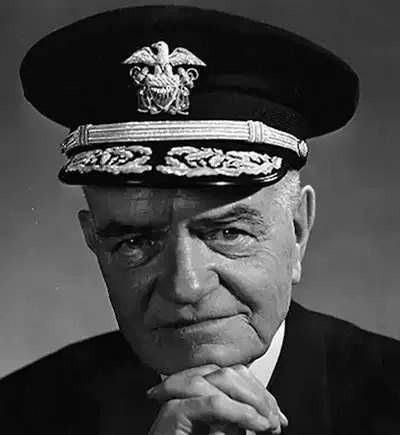- Military History
- Biographies
- Militarians Biographies
- Fleet Admiral William Frederick Halsey Jr.
Fleet Admiral William Frederick Halsey Jr.
Halsey rose to commander of the Third Fleet and the Western Pacific Task Forces in 1944. He was responsible for covering and supporting US land operations and led his carrier task force to brilliant air strikes
William Frederick Halsey Jr., a US naval commander who led many of the most important US naval campaigns in the Pacific during WW II, was born on October 30, 1882 in Elizabeth, New Jersey to US Navy Captain William F. Halsey Sr. and his wife Anne Masters Brewster. He attended the Pingry School in New Jersey and, while waiting to receive an appointment to the United States Naval Academy, started his medical studies at the University of Virginia. In 1900, he finally entered the US Naval Academy at Annapolis, from which he graduated in 1904.
From 1907 to 1909, Halsey sailed with the "Great White Fleet" aboard the USS Kansas as a midshipman and then served aboard several torpedo boats, which soon became his specialty as full lieutenant. During WW I, Halsey commanded several torpedo boats and destroyers in convoy escort duty across the North Atlantic and was awarded the Navy Cross.
In the interwar years, Halsey served as a Naval Attaché at the American Embassy in Berlin, Germany and was given additional duty as Naval Attaché at the American Embassies in Christiania, Norway, Copenhagen, Denmark and Stockholm, Sweden, before returning to sea and commanding groups of destroyers as Captain. He also attended flight school, earning the wings of a naval pilot at 52. Halsey commanded the aircraft carrier USS Saratoga and later the Naval Air Station Pensacola at Pensacola, Florida, being promoted to Rear Admiral in 1938.
When the US entered World War II, Halsey was a vice-admiral in command of the aircraft carrier USS Enterprise. Away from Pearl Harbor, he escaped the Japanese attack of December 7, 1941, and his battle group was the only operational one left in the Pacific. While the US rebuilt the fleet, Halsey wasn’t content to defend in the Pacific, but attacked the Japanese at islands in the Marshalls and Gilberts and on Wake Island early in 1942.
Even more important for US morale, he brought the USS Hornet within 800 miles (1,287 km) of Japan allowing Lieutenant Colonel James Doolittle to launch his B-25 bombers from the aircraft carrier's deck and to carry out the first aerial bombing of Tokyo on April 18, 1942.
As the United States rallied from the destruction of Pearl Harbor, Halsey became a household name; newspapers called him "Bull." In October 1942, Halsey was named Commander of the South Pacific Force and, after playing a vital role in defeating the Japanese at the Battle of the Santa Cruz Islands and the Naval Battle of Guadalcanal, promoted to full admiral. From 1942 to 1944, he directed the US campaign in the Solomon Islands.
Halsey rose to commander of the Third Fleet and the Western Pacific Task Force in 1944. He covered and supported US land operations and led his carrier task force to brilliant air strikes. Halsey directed the first carrier attack against an inland enemy flight station in the Philippines and supported the invasion of the islands by General Douglas MacArthur.
His most controversial battle was in Leyte Gulf (1944). Halsey was lured away from the battle area by a decoy Japanese force. This allowed the main Japanese fleet to enter the gulf and attack US ships there. Despite being drawn away, Halsey directed his planes in the attack and they sank four Japanese carriers. After this rocky start to the battle, the United States won the most impressive naval victory of the war.
Halsey directed his fleet in the carrier attack on Okinawa, and his planes struck again and again at the Japanese mainland, including Tokyo. The Japanese surrender was conducted aboard his flagship, the USS Missouri, although it was General MacArthur who led the US delegation. Promoted to fleet admiral in 1945, Halsey retired from the navy in 1947 and joined the board of two subsidiaries of the International Telephone and Telegraph Company, including the American Cable and Radio Corporation, from 1951 to 1957.
William Halsey died on August 16, 1959, while vacationing on Fishers Island, New York. His remains were laid to rest at the Arlington National Cemetery next to his wife’s and near his parent’s.
Fleet Admiral William Frederick Halsey Jr. - Quick Facts
- WWI (1914-1918)
- WWII (1939-1945)
- Pacific War (1941-1945)
- {{#owner}}
- {{#url}} {{#avatarSrc}}
{{name}} {{/url}} {{^url}} {{#avatar}} {{& avatar}} {{/avatar}} {{name}} {{/url}} - {{/owner}} {{#created}}
- {{created}} {{/created}}
























